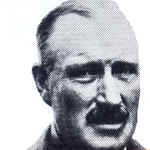Lieutenant-General Neil Ritchie commanded the British 8th Army during the Battle of Gazala. This battle ended with the loss of Tobruk and Ritchie, along with Claude Auchinleck, bore the brunt of Winston Churchill’s anger – the British Prime Minister called the surrender of Tobruk a “disgrace”.
 |
Ritchie was born in 1897 and educated at Lancing College in West Sussex. From Lancing, Ritchie went to the RMA at Sandhurst. Upon graduating he received a commission in the Black Watch. During World War One he fought in France and Mesopotamia. In 1918, he was awarded the Military Cross.
After the war, Ritchie decided to make a career out of the Army and by 1939, he had risen to the rank of brigadier. In 1939, Ritchie went to France with the BEF and served as chief-of-staff under General Alan Brooke.
After Dunkirk, Ritchie served under General Claude Auchinleck. In July 1941, Auchinleck was given the command of British forces in the Middle East. In November 1941, Auchinleck gave Ritchie the command of the 8th Army. Many did not approve of this decision, as Ritchie had not had command of a large field unit since World War One.
On November 18th, 1941, the British launched ‘Operation Crusader’. This offensive stopped Erwin Rommel from besieging Tobruk and by January 1942, the British were pushing the Afrika Korps back west.
Between January and May 1942, a lull in fighting took place in North Africa. Both sides had the opportunity to reorganise themselves. However, the lack of an offensive and aggressive campaign angered Winston Churchill. He gave Auchinleck what was effectively an ultimatum – resign your command or attack. Auchinleck gave a promise of an attack in June.
However, he was beaten to it by Rommel who launched an attack on British positions on May 26th. Thus started the Battle of Gazala.
Ritchie was given the task by Auchinleck of stemming Rommel’s attack. Ritchie’s first line of defence was the so-called Gazala Line. On paper, Ritchie had an immensely powerful barrier to fight behind. However, the British defenders had reckoned on an attack along the northern coastal road. Rommel ordered what was a diversionary attack here but made his main attack in the southern sector of the Gazala Line where he gambled on the fact that the Gazala Line was not as strong as was expected.
Ritchie had superior numbers to Rommel in terms of manpower – 100,000 to 90,000. Ritchie could also muster 849 tanks to Rommel’s 560 even if Rommel had more serviceable planes available. However, the major difference came in the tactics used. Rommel used tanks in powerful concentrated numbers while Ritchie did not. On June 12th, two British armoured brigades were caught in a pincer movement and badly beaten. This left Ritchie with only one armoured brigade left. On June 14th, Ritchie ordered that Gazala should be abandoned and he left with just 100 tanks.
Tobruk fell to Rommel’s forces on June 21st. The Afrika Korps took 35,000 prisoners. Churchill called the fall of Tobruk a “disgrace”. Ritchie was replaced as commander of the 8th Army by Bernard Montgomery.
For D-Day in June 1944, Lt-General Ritchie was made the commander of 12th Corps.
Ritchie continued in the army after the war ended. He was given command of Scottish forces. In 1947, he became commander-in-chief of British land forces in the Far East until his retirement.
Neil Ritchie died in 1983.
Related Posts
- The Battle of Gazala was fought in North Africa in 1942 and culminated with the Allies losing Tobruk – a defeat Winston Churchill called a…
- The Battle of Gazala was fought in North Africa in 1942 and culminated with the Allies losing Tobruk – a defeat Winston Churchill called a…